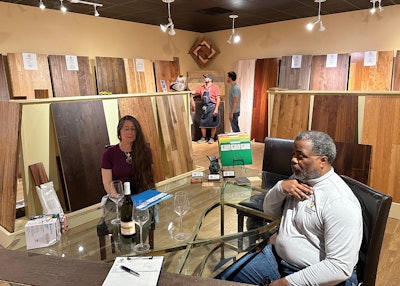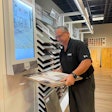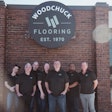
Over my decades in this business I’ve had the good fortune to also work for some major wood flooring manufacturers, starting with Bruce (back in the Triangle Pacific days) and then being a rep for a huge Asian manufacturer, as well as sourcing products throughout Asia, South America and Europe. In this time, I’ve visited mills around the world and visited countless retailer showrooms. I still cover a large territory as a rep for a large wood flooring manufacturer, but for the last 12 years I’ve also operated my own retail showroom in my hometown here in Pennsylvania.
From these decades of seeing the business from both sides and visiting countless retailers, here is some advice I would offer fellow wood flooring retailers.
1) Educate your salespeople.
The average retail salesperson does not have knowledge or the opportunity to learn about all the types of wood flooring.
In contrast, selling carpeting is easy: There’s good, better, best. It goes over any subfloor. It needs a pad (again, good, better or best?). You ask the consumer: Which color do you like? We’ll send our estimator out. Done. Easy!
Selling laminate or LVP is also easy. The consumer already thinks it’s dog-proof, kid-proof and waterproof. It goes over almost anything. There are basically two prices, and it looks like wood (I always say it’s like a toupee—looks like the real thing, but it’s fake). You ask the consumer: Which one do you like? We’ll send our estimator out. Done. Easy!
Now let’s talk about wood flooring. The salesperson needs to ask about lifestyles, pets, subfloors, if it’s on-grade or below-grade, and what are the requested widths? Then with that, the salesperson needs to know from his available samples which is the correct one for that application. You must consider glue-down, nail-down and floating methods; species; thicknesses of wear layers and different finishes.
2) Make sure samples represent the actual product.
I like to build my own samples. Speaking as someone who has been in wood floor factories around the world, I can tell you that many times the person building the samples has simply been told to make 50 samples—they could easily put together one sample that’s all from the same couple of boards. I mount my samples on a hollowcore door so you can see the longest and the shortest lengths in that product, as well as all the character that’s in it. When new products come in, all the salespeople should open up the boxes so they see what the product actually looks like, or, better yet, go out on jobs where it’s being installed to see it (and talk to the installer to find out if it’s a great product or if it’s junk, in which case you should drop it).
3) Limit your displays.
Many retailers try to jam all the samples from every manufacturer into their showroom. How many colors of brown do you really need to show? You can overwhelm your customer. Instead, for my bigger samples I like to focus on what I consider to be unique products. I’ve got a nice wide-plank hickory engineered floor in what I think is the most popular color now; if a customer sees that large sample of the hickory and likes the look but not the color, then I can pull out smaller samples for them to look at. Then I’ll have things like a big amendoim panel; that’s an exotic that I think bridges the gap between red (which used to be popular) and brown (which is popular now), and it also has a three-dimensional effect. If you didn’t see a bigger sample, you’d only see 3 inches of that sticking out and wouldn’t notice it. Maybe you aren’t going to sell a ton of those unique products, but it shows your customers you have expertise beyond the average products they see at every other flooring retailer.
4) Educate your customer.
I want my customers to be as educated as they can be on wood flooring. Whether they take samples or not, everybody who comes in gets a wood floor folder information packet. It includes a Janka hardness chart that I personalized, a sheet explaining that I’m a member of the National Wood Flooring Association and their code of ethics, a customer service guide that I personally wrote, and more. I have a sample showing how dry-sawn engineered flooring is cut. As they walk around the showroom, they have a carbonless sheet of paper with their name on it where we write down prices of products that interest them; then we both have a copy and something we can use to follow up with.
5) Put your better products in front.
Just like in a car dealership, you should put your more expensive products in front, and if you sell floor coverings besides wood, that means your wood flooring is right there when they walk in. Maybe you can include some panels at a special price, and there’s also a lot of engineered wood flooring that’s not bad-looking now that I can sell at the same price as laminate. Oftentimes people will come in asking for a cheaper product, and the salesperson will only show them that product—and that leaves money on the table. With a little education, when you talk about the long-term value of a wood floor and how it’s a lifetime product, many times they’ll end up choosing a better product. For example, last Saturday I had a young couple in my shop asking for a laminate. We talked about the lifespan of the product, and the fact that laminate has ugly overhang and trims you have to use (they’ve gotten better, but again, it goes back to that whole toupee thing). They really liked a distressed wood floor that was a little less than twice the price of the laminate. Considering they needed only about 500 square feet, the extra cost often will become worth the money to the customer to get a better product they really love.
6) Do something special.
If you come into our store late in the afternoon, I’ll ask you if you would like a glass of wine in a nice stemmed glass (I also have beer for the customers who prefer that). Oftentimes one of my friends or wood flooring colleagues will stop in, and it makes for a relaxed, fun atmosphere in the showroom. If they buy a floor from me, when they come in to pay their bill, I give them a little wine bag with the “Hardwood Floors of Lancaster” logo on it and a nice bottle of wine as a gift.
Years ago at a sales seminar, the speaker told us that our customers are going to visit three to five other retailers before making a decision, so you have to prove that you’re the one they should buy their flooring from. Make sure you’re doing these simple things to stand out from the average retailers and sell more wood flooring.

































